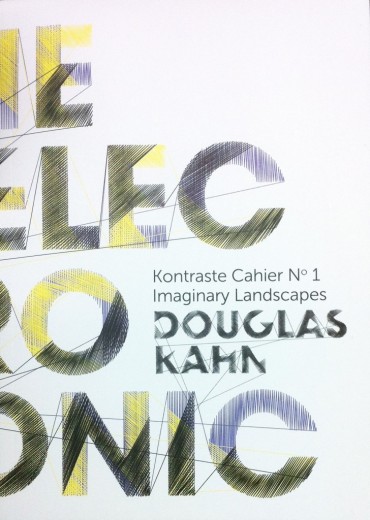Douglas Kahn: The Aelectrosonic (2011)
Filed under book | Tags: · electromagnetism, electronic music, sound art, sound recording

“Kontraste Cahier #1, The Aelectrosonic is published on occasion of the Kontraste festival Imaginary Landscapes (2011). In this richly illustrated book sound historian Douglas Kahn explores the notion of the Aelectrosonic, the electromagnetic analogue of the Aeolian, and locates the roots of electronic music in the 19th century when Thomas Watson listened in to the sounds of the telephone wires.
Kontraste Cahier #1, The Aelectrosonic is the first in what will be a series of small books, each centered around a commissioned essay.”
Edited by Arie Altena & Sonic Acts
Published by Sonic Acts Press
Design by Femke Herregraven
64 pages
PDF, PDF (updated on 2020-8-12)
Comment (1)Michael B. Schiffer: Power Struggles: Scientific Authority and the Creation of Practical Electricity Before Edison (2008)
Filed under book | Tags: · 1800s, electricity, electromagnetism, history of technology, light, technology

In 1882, Thomas Edison and his Edison Electric Light Company unveiled the first large-scale electrical system in the world to light a stretch of offices in a city. This was a monumental achievement, but it was not the beginning of the electrical age. The first electric generators were built in the 1830s, the earliest commercial lighting systems before 1860, and the first commercial application of generator-powered lights (in lighthouses) in the early 1860s. In Power Struggles, Michael Brian Schiffer examines some of these earlier efforts (both successful and unsuccessful) that paved the way for Edison.
After laying out a unified theoretical framework for understanding technological change, Schiffer presents a series of fascinating case studies of pre-Edison electrical technologies, including Volta’s electrochemical battery, Thomas Davenport’s electric motor, the first mechanical generators, Morse’s telegraph, the Atlantic cable, and the lighting of the dome of the U.S. Capitol. Schiffer discusses claims of “practicality” and “impracticality” (sometimes hotly contested) made for these technologies, and examines the central role of the scientific authority—in particular, the activities of Joseph Henry, mid-nineteenth-century America’s foremost scientist—in determining the fate of particular technologies.
These emerging electrical technologies formed the foundation of the modern industrial world. Schiffer shows how and why they became commercial products in the context of an evolving corporate capitalism in which conflicting judgments of practicality sometimes turned into power struggles.
Publisher MIT Press, 2008
Lemelson Center Studies in Invention and Innovation Series
ISBN 0262195828, 9780262195829
420 pages
Reclaim the Spectrum catalogue (2006) [Spanish/English]
Filed under catalogue | Tags: · electromagnetism, open spectrum, wireless networks

The radio spectrum – the electromagnetic space through which radio and TV broadcasts, mobile phone and GPS signals and WiFi networks circulate – is the real estate of the information society. Its invisible infrastructure is the largest engineering project in the history of man; its gradual colonisation and conquest throughout the 20th century has radically transformed the structure of society, the shape of cities and the relationship between individuals.
In spite of this, there’s a lot we don’t know about the spectrum: who owns it, how it’s managed, who decides how it’s used. Although supposedly a scarce and valuable resource, discussion about the spectrum is not a political priority and its regulation is rarely subject to public scrutiny. While the “Lords of the Spectrum” (the military, broadcasting industries, telecommunications providers) have enjoyed exclusive rights to the most useful frequencies for decades, the comparatively insufficient public frequencies have produced some of the most socially beneficial innovations, such as wireless Internet networks. From many different areas, there is an increasing demand that we begin to understand and manage the frequency system as public space, because we are increasingly taking more and more social processes and dynamics out of the streets and into the airwaves.
Now that contrary standards such as third-generation mobile phone services and wireless are competing for the same users, it is becoming an urgent priority to reclaim the right to make decisions about the most socially fruitful uses of the spectrum. Are more TV stations and video messages on our mobiles really what we need? Do we want technologies that allow us to be participants, or just consumers?
Artists, designers and activists are being the first to make the leap to appropriate Hertzian space and rework it to subvert its ends. Sometimes, by making what occurs in the realm of the airwaves visible, and mapping it to show how in the spectrum the borders between public and private space blur. In other cases, by encouraging the use of wireless networks to create active location-based communities, as used to happen in public squares or parks. And in almost all cases, by showing how our current use of the spectrum depends more on political and commercial decisions than in the full reach of its technical potential.
Somewhere in between the utopian discourse of those who want a commons of the airwaves and those who subvert and hack communication protocols and devices in total rejection of the controlled use of this technology, those who reclaim the spectrum are anticipating a political and social debate that was missing in the 20th century and cannot be postponed in the 21st.
Texts by José Luis de Vicente, Erich Berger, Julian Bleecker, Jonah Brucker-Cohen, Usman Haque, Anab Jaim, Jill Magid, Michelle Teran, and Rubén Díaz ZEMOS98.
A project by José Luis de Vicente for zemos98.
Catalogue edited by Rubén Díaz
Published under a Creative Commons BY-NC 2.5 license.

